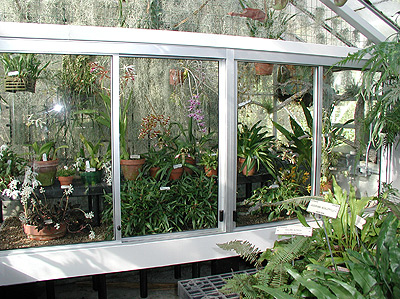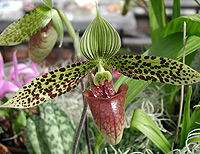Berkeleyan
 |
Garden staff have installed a custom-designed display case in the Orchid, Fern and Carnivorous Plant House. (Photo courtesy UC Botanical Garden) |
 View slide show: Orchids from the world's four corners View slide show: Orchids from the world's four corners |
Attention, orchid-gawkers!
These celebrity-status plants are on public display in Strawberry Canyon once more
![]()
| 08 February 2006
For the first time this century, members of the public can commune with members of the Orchidaceae family when visiting the UC Botanical Garden. Dozens of orchid species, many of them rare and endangered, are now on view in the Orchid, Fern, and Carnivorous Plant House, with new specimens rotating in regularly as they come into bloom.
This week garden visitors can get a close look at an elegant lady slipper (Paphiopedilum hirsutissimum) from India; an Oncidium with pink-and-white flowers (imitating the bees in its native Ecuadorian habitat); a Mexican beauty (Lycaste consobrina) with waxy yellow flowers and yellow-green sepals, and nearly three dozen other orchid specimens.
The botanical garden boasts one of the largest orchid collections in North America, with more than 600 species gathered in the wild on every continent except Antarctica. In 2000, however, a mixed-use greenhouse was converted to an arid house - leaving the moisture-loving orchids without a secure facility for public display. Recently, garden staff decided to add space for orchids to a new display area for the carnivorous-plant collection (since both types of plants like warm, moist conditions), thus making it possible to display orchid beauties during the long wait for a permanent public greenhouse for the entire Orchidaceae collection. In late January they installed a custom-designed display case - 37 feet in length, 3 feet deep, 6 feet high, and low enough for small children to marvel at fly-imitating orchids and bug-devouring butterworts.
 The orchid collection includes the looker above, Paphiopedilum sukhakulii, an endangered lady-slipper found only on Thailand's Phu Lnang Mountain. (Photo courtesy UC Botanical Garden) |
The garden's orchid collection is rich in species from southeast Asia and Central and South America - some of them so rare, in the wild, that they are known to grow on a single limestone cliff, says orchid horticulturist Jerry Parsons. Many of the species come from scientific-research expeditions dating back as far as the 1940s; a number were confiscated from poachers. Wild orchids are protected under international conventions, and the UC Botanical Garden serves as one of the designated rescue centers for contraband plants. That's how the abovementioned Ecuadorian Oncidium, for one, came to live in the Strawberry Canyon collection.
Orchid specimens in Parsons' care, when in bloom, smell variously like coconut sun lotion, cinnamon, chocolate, vanilla, or "the wax lips you wore as a kid on Halloween," he says. Some are valued for their patterned foliage, others have no leaves at all. He is keeping a close eye on one of the latter, the rare and legally protected Ghost orchid (Polyradicion lindenii), made famous by the 2002 film Adaptation based on Susan Orlean's book The Orchid Thief. As soon as this leafless plant puts out its white flower, Parsons says, he plans to rotate the Ghost orchid into the display case. (A best-case scenario, he notes, would be a timely bloom in early summer to coincide with the national meeting of the American Public Garden Association, scheduled for the Bay Area June 28 to July 1; the Berkeley botanical garden is one of several hosts for this event.)
The orchids' neighbors in the Orchid, Fern, and Carnivorous Plant House include some 40 carnivorous plants with all manner of intriguing evolutionary strategies for luring, trapping, and digesting animal prey. This greenhouse is open from 9 a.m. to 4 p.m. daily.

